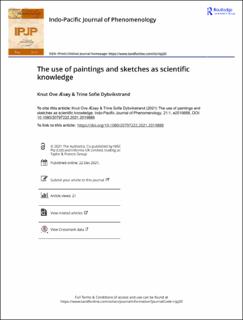The use of paintings and sketches as scientific knowledge
Peer reviewed, Journal article
Published version
Date
2021-12-22Metadata
Show full item recordCollections
Original version
https://doi.org/10.1080/20797222.2021.2019888Abstract
This article is written in the field of the philosophy of science. The aim is to express how painting and drawing can be used as part of a phenomenological research method. The painter or drawer is a visual researcher in the process of capturing a holistic and truthful experience of a cultural phenomenon. We will highlight the visual researcher process and how the experience of truth is known throughout this process. The paining and sketches, which we present in this article, are part of a book, together with written narratives and pedagogical theory – on teaching as a phenomenon – called Lærerpraksis og Pedagogisk teori. The paintings and drawings present teaching in a way that complements and expands the written text. The sketches and painting of teaching attempt to establish the truth as unconcealment of a phenomenon. Our argumentation is based on the theories of Gadamer, Cassirer, Panofsky and Heidegger. Gadamer connects humanistic research with artistry and the experience of truth. Cassirer argues that the perception of a cultural phenomenon begins as a holistic understanding to bring forth the symbolic form or essence of the phenomenon. Panofsky transfers the theory of Cassirer into the field of painting. The concept of synthetic intuition is the intrinsic knowing of a painting, which corresponds to Cassirer’s concept of symbolic forms. Heidegger’s theory explores how art unfolds and preserves the truth. We will argue that the connection between art and truth could bring forth important perspectives on phenomenological science and turn the research activity closer to an artistic form.

